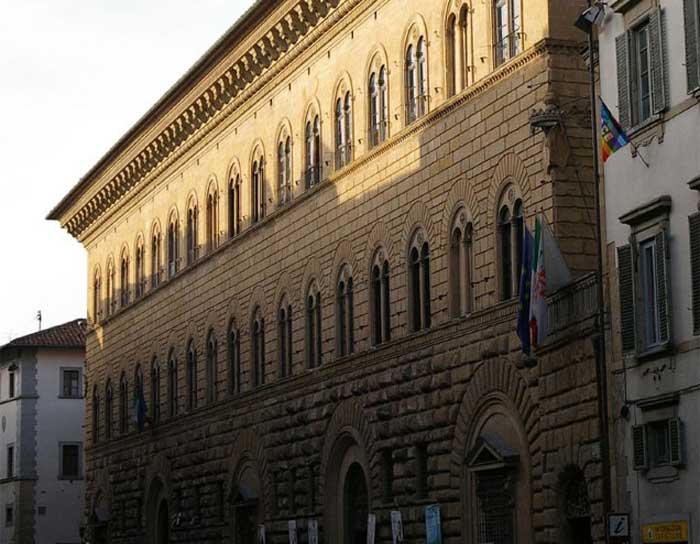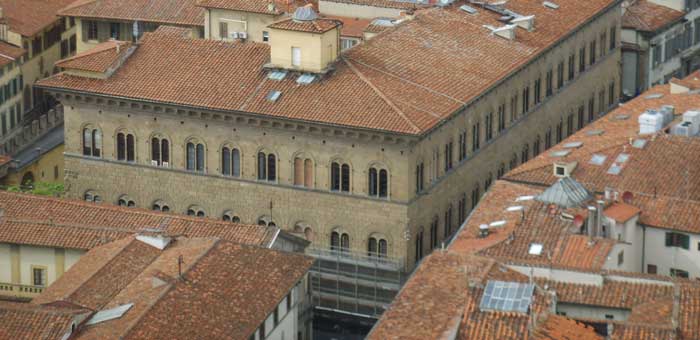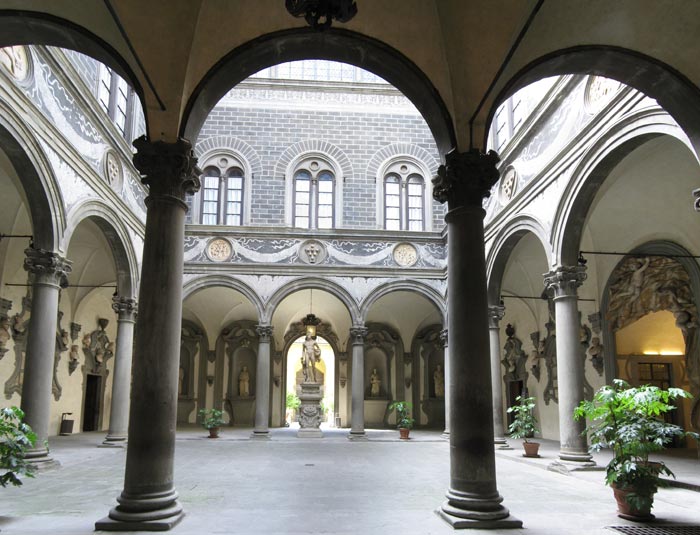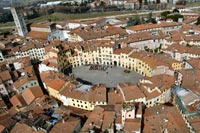| |
|
Procession of the Magi in the Palazzo Medici-Riccardi in Florence (1459-60)
|
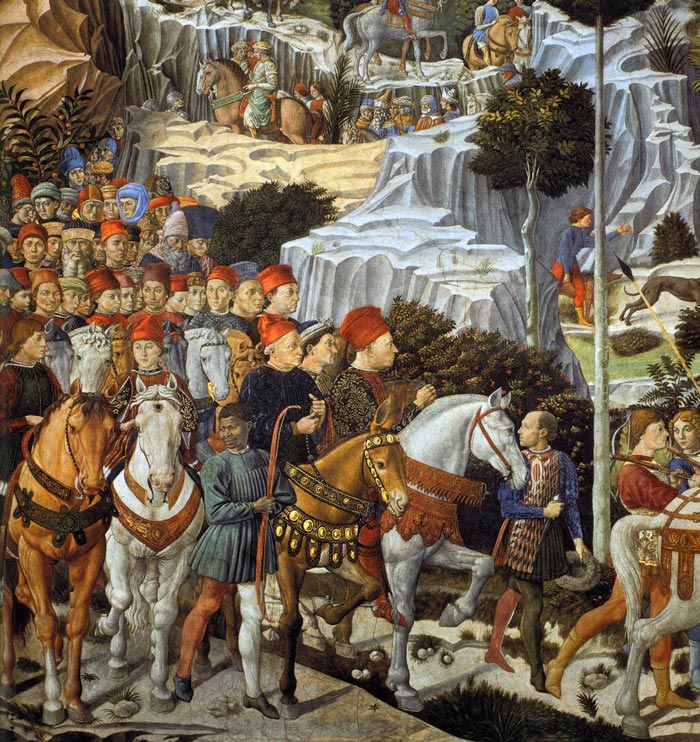 |
 |
Benozzo Gozzoli, Procession of the Youngest King (detail), 1459-60, Palazzo Medici-Riccardi, Firenze
|
|
The Chapel of the Magi occupies an important place in the Medici Palace. In its original aspect preceding the "cutting-out" of a corner desired by subsequent owners of the Palace, the Marchesi Riccardi in 1699, the Chapel was perfectly symmetrical, and had its entrance through the central door, which today is closed. Inside, the Chapel is divided into two juxtaposed squares: a large hall and a raised rectangular apse with an altar and two small lateral sacristies. Begun around 1449-50, the Chapel was probably terminated in 1459 with the precious ceiling of inlaid wood, painted and generously gilded attributed to Pagno di Lapo Portigiano, according to Michelozzo's design.
The latter also designed the flooring of marble mosaic work divided by elaborate geometric design, which due to the extraordinary value of the materials (porphyries, granites, etc.), affirmed the Medicis' desire to emulate the magnificence of the Roman basilicas and the Florentine Baptistry.
The first pictorial element in the Chapel was the altar panel bearing Filippo Lippi's Adoration of the "Christ Child", which was sold during the last century and today is in Berlin. In its place is a copy attributed to the Pseudo Pier Francesco Fiorentino, a follower of Lippi, which has fully regained its orignal beauty due its restoration completed in 1992. The Chapel is famous for the series of wall paintings by Benozzo Gozzoli, with the Angels in Adoration in the rectangular apse and the "Journey of the Magi" in the large hall. Painted during the years subsequent to 1459, but in any case by 1463, they represent the masterpiece oft his painter, dedicated to a sacred subject but rich in traces of pomp and seculare legance with all the care that Cosimo and Piero de' Medici - as exigent buyers and connoisseurs of art - expected of him. Hosts of angels sing and adore on a rural background civilly partioned, like the typical Florentine countryside. While the magnificent procession of the Three Kings approaches Bethelem accompanied by their respective entourages they enjoy the scene of a noble hunting party with falcone and felines along the way. The sumptuous and varied costumes with their princely finishings make this pictorial series one of the most fascinating testimonies of art and costume of all time. Among the followers of the Magi there are numerous family portraits.
On the north wall, in the entourage of young King Kaspar (whom poetic tradition considers an ideal portrait of Lorenzo de' Medici, the future "Magnifico"), may identified Cosimo with his sons Piero, Giovanni and Carlo, the young princes Lorenzo and Giuliano di Piero and the painter Benozzo. The restoration of the paintings (1987-1992) have revealed a refined and complex operational technique and made it possible to fully appreciate Benozzo's compositional capacity. He was a skilled constructor of animated landscape backdrops in perspective, besides being an analytical witness of the knightly pomp of the Court, in which are incorporated the memories of magnificent parades which, during the Feast of Magi the and on other important celebrative occasions, wended their way along the Via Larga under the palace windows. The precious interior decoration of the Chapel is completed by a wooden baldachin worked in inlay and carving, whose architectural design is attributed to Giuliano da Sangallo, around 1469.
Entrance to the Chapel is limited to a maximum of 8 visitors every 7 minutes
Bookings operate on a “fast lane” basis, offering priority entrance at the beginning of every hour – from 9.00 to 18.00 – for a maximum number of 25 people at a time. Visitors who have booked should report to the ticket office at least 15 minutes before the booked time.
Ticket sales close at 18.30
Address Palazzo Medici Riccardi. Via Cavour 1, Florence
Opening hours: Every day except Wednesday from 9.00 to 19.00
|
|

Giovanni di Cosimo de' Medici. Detail from the fresco by Benozzo Gozzoli, in the "Cappella dei Magi", at Palazzo Medici Riccardi in Florence, Italy.
 East Wall, alleged portrait of Lorenzo il Magnifico East Wall, alleged portrait of Lorenzo il Magnifico
|
The courtyard
|
|
|
|
Palazzo Medici-Riccardi in Florence, courtyard of the columns (known as ‘Michelozzo’s courtyard’)
|
The archway leads into the square courtyard, with the over life-size statue of Orpheus by Baccio Bandinelli and twelve marble medallions above the colonnade and to the smaller garden courtyard.
|
'The marble sculpture portrays Orpheus enchanting with his song the three-headed dog Cerberus, the guardian of the underworld. The youth’s face has harmonious lineaments, framed by long, curling hair that falls softly to his shoulders. The hero is shown completely nude, with a cloak falling from his shoulders at the back, held up by the left arm. He is wearing sandals. In his right hand he is holding the bottom of the lyre, which has been lost. Cerberus, now docile, is seated behind the right leg of Orpheus, and the youth appears to be leaving the tamed hound behind him as he continues to move towards Eurydice, his gaze turned upwards.
Orpheus, son of Apollo or of the river-god Oeagrus, was a musician and a sublime singer, whose music could tame wild beasts, bend the boughs of the trees and move even the hardest of hearts. In his desperate attempt to reach his beloved dead wife Eurydice in the world of Hades, he overcomes all adversities, placating the monsters and the fierce guardians that he meets thanks to the art of his music. Through the intercession of Persephone, the god Pluto, King of the Underworld, agrees to allow Orpheus bring Eurydice back with him to the world of the living, as long as he walks in front of her and does not turn to look at her until they have arrived in the world of light above. However, as soon as Orpheus himself reaches the light, before Eurydice has set foot in the upper world, he turns towards his beloved, and thus loses her forever.
The myth of Orpheus is told, among others, by Ovid (Metamorphoses, X, 1-85) and Virgil (Georgics, IV, 453-527). In 1480 Agnolo Poliziano wrote the Fabula di Orfeo.
The myth of Orpheus was a story dear to the Medici, since it symbolically recalled the pacifying effect of their government of Florence (Langedijk 1976). Medici policy, marked by wisdom and force of persuasion, was thus associated with the music of Orpheus, which moves and sweetly softens hearts: both have the power to civilise and establish harmony and concord. Moreover, the effigy of the mythical Orpheus with his lyre recalls that of the Biblical king David with his zither.
Also referring to the iconography of Orpheus is the bronze attributed to Bertoldo di Giovanni, also identified with Apollo or Amphion, originating from the Medici collections and now in the Bargello Museum(inv. Bronzi n. 349). A sixteenth-century painting (c. 1537-1539?) that can be referred to the circle of Agnolo Bronzino, now in the Philadelphia Museum of Art (inv. n. 1950-86-1), represents a portrait of Cosimo I - or, as others believe, Francesco I – dressed as Orpheus.[2]
|
|
 Baccio Bandinelli, Orpheus enchanting Cerberus, circa 1519 |
|
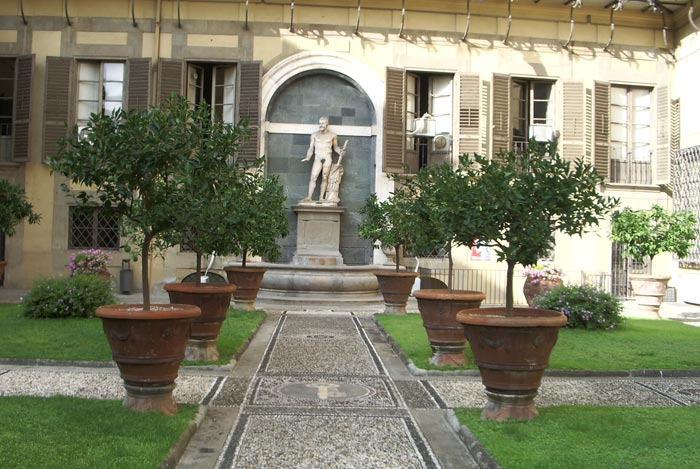 |
Garden of Palazzo Medici-Riccardi in Florence, the second courtyard decorated with ornamental statues and potted lemon trees |
|
|
| |
|

[1] Benozzo di Lese di Sandro, or Benozzo Gozzolo, was probably born in the autumn-winter of 1421 in Florence. The name Gozzolo, by which the artist came to be known, appears in the other branch of the painter’s family, wealthy farmers and landowners who resided in the district of San Colombano a Settimo.
He was a pupil of Fra’ Giovanni da Fiesole, known as Angelico, and became his principal assistant in the fresco decoration of the convent of San Marco. From at least 1439, however, he was also working independently, executing more modest commissions.
Having detached himself temporarily from the workshop of the Dominican friar, on 24 January 1445 Benozzo joined the ranks of the assistants of Lorenzo Ghiberti engaged in the execution of the east door of the Baptistery, known as the ‘Gate of Paradise’.
The contract bound him for three years, but in 1447 he had already returned to the side of Fra’ Angelico, joining him first in Rome and then following him to Orvieto to work on the decoration of the chapel of San Brizio in the Duomo. In the contract for this enterprise Benozzo is defined as “co-partner” of Fra’ Angelico. Gozzoli offered to complete the cycle but did not obtain the contract. In 1448 the two artists were in Rome again, engaged by Nicholas V to fresco the private chapel in the Vatican with Scenes from the Lives of Saint Stephen and Saint Lawrence, completed before 1450.
In the following decade Benozzo was engaged in various cities of the Papal State between Umbria and Lazio executing both frescoes and panel paintings. Between 1450 and 1452 he left some of his most important works in Montefalco, including the frescoes in San Fortunato and in San Francesco. The artist probably continued to work outside Florence, although he returned to the city from time to time. In 1458 he went to Rome to make standards for the celebrations organised to celebrate the election of Pius II Piccolomini as Pope.
Having returned to Florence in 1459, he was appointed by Piero il Gottoso de’ Medici to fresco the chapel of Palazzo Medici with the Procession of the Magi, the Vigil of the Shepherds and the Adoration of the Angels. This was a commission of enormous prestige, the fame of which outreached that of the artist himself.
Benozzo remained in Florence for four years. He painted the Madonna and Saints for the Compagnia della Purificazione with its headquarters in San Marco (1461; London, National Gallery) and the panel for the Alessandri in San Pier Maggiore (predella at the Metropolitan Museum, New York). He married Lena di Luca, by whom he was to have many children. He lived in a house that he owned in Via del Cocomero (now Via Ricasoli).
In the years that followed, the artist worked in San Gimignano and in other towns of the Valdelsa (Castelfiorentino, Monte Oliveto, Certaldo). In San Gimignano, availing of the assistance of various collaborators, Benozzo frescoed the high altar of Sant’Agostino (1464-5) and executed a number of works in fresco and tempera.
At the end of 1467 he left the town to move to Pisa, where he remained up to 1484. He devoted much of his time during this long sojourn to painting the fresco cycle illustrating Biblical Scenes on the north wall of the Camposanto, which earned him great popularity. In the meantime he also executed various commissions in several nearby towns, including Legoli (where he had moved temporarily on account of an outbreak of plague) and Volterra. Among his assistants in these years were a number of relatives: his two brothers Bernardo and Giovanni and his three sons Francesco, Gerolamo and Alesso.
After the banishment from Florence of Piero de’ Medici, son of Lorenzo il Magnifico and the arrival of Charles VIII of France (1494), Benozzo and the other Florentine artists resident in Pisa had to leave the city, which had taken advantage of the upheaval to regain its independence. Having returned to Florence in 1497, along with Cosimo Rosselli, Pietro Perugino and Filippino Lippi he was appointed to appraise the frescoes of Alesso Baldovinetti in the church of Santa Trinita, since these artists were the finest frescoes painters in the city at the time.
Shortly afterwards Benozzo moved to Pistoia, most probably to execute the fresco of the Maestà in the Sala Ghibellina of the Palazzo Comunale. However he died, possibly of the plague, before he was able to complete the work. He was buried in the Camposanto in Pisa.
Mediateca di Palazzo Medici Riccardi | Benozzo di Lese, known as Benozzo Gozzoli
[2] Baccio Bandinelli, Orpheus enchanting Cerberus | History | 'After their return from exile in 1512, the Medici were concerned to refurnish the areas on the ground floor of Palazzo Medici, in particular the courtyard and the garden, which had been irremediably deprived of some of the masterpieces, which had remained the property of the Signoria after the confiscation carried out in 1495 with the advent of the Republic. Thus, Cardinal Giulio (later Pope Clement VII), the cousin of Pope Leo X, commissioned from Giovan Francesco Rustici a model for a David in bronze to replace that of Donatello, which the family had renounced in the interim.
According to Vasari (1568), despite having produced the terracotta model, Rustici lost the commission, which was passed to Baccio Bandinelli. In effect, in the interim Bandinelli had gone to Leo X in Rome to request the commission, showing him his own model. The two models were probably executed between 1515 and 1517 (Caglioti 2000, p. 353).
According to Vasari’s account (1568), the Pope greatly appreciated Bandinelli’s work, but instead of immediately entrusting to him the task of creating the new David for Palazzo Medici in Florence, he sent him to work in the basilica of Loreto. Having returned to Rome after bitter disputes with Andrea Sansovino, Baccio finally obtained from the Pope the commission for the statue for the courtyard of Palazzo Medici, thanks to the intercession of Cardinal Giulio.
However, in the interim, for motives of political expediency Pope Leo X and his cousin Cardinal Giulio had decided to abandon the subject already proposed in the fifteenth-century bronze, dense with political and civil significance and allusions, and to select instead a subject devoid of such implications (see above Description, subject). Cardinal Medici asked Baccio Bandinelli to sculpt in marble a statue of Orpheus enchanting Cerberus to be set upon a new pedestal made by Benedetto da Rovezzano and Simone Mosca (see record: Pedestal with Medici arms and devices, by Benedetto da Rovezzano).
On 12 July 1519 Baccio Bandinelli is recorded as receiving from the Opera di Santa Maria del Fiore a block of marble for a statue, which has been hypothetically identified as the Orpheus (Waldmann 2004, p. XVI).
For his Orpheus Bandinelli drew inspiration from the Apollo del Belvedere (Vatican City, Vatican Museums, Museo Pio-Clementino), discovered at the end of the fifteenth century and set up in 1511 in the courtyard of the same name in the Vatican .
Bandinelli’s statue was placed on its pedestal in the courtyard of Palazzo Medici, beneath the middle arch on the western side of the portico, further back than the meeting-point of the diagonals of the courtyard, where Donatello’s David had previously been positioned, set upon the column by Desiderio da Settignano. Bandinelli’s work was set in place when Giulio “governed Florence” (Vasari 1568), that is, at the end of 1519: in fact, with the death of Lorenzo di Piero de’ Medici, Duke of Urbino and captain of the Florentine Republic on 4 May 1519, the government of the city was temporarily entrusted to Goro Gheri, Lorenzo’s secretary, until Giulio took over direct control in October.
According to Caglioti (2000, p. 353) the commissioning of the Orpheus from Bandinelli can be dated shortly after the summer of 1518, in view of the arrival of Lorenzo Duke of Urbino, nephew of PopeLeo X, who had been in France since March. At the court of Francis I, Lorenzo had in fact acted as godfather to the king’s son and had married Madeleine de la Tour d’Auvergne. The married couple then made their triumphal entry into Florence on 7 September.
Rogers Mariotti (2001-2002), on the other hand, considers that Bandinelli was commissioned to create the sculpture after May 1519, that is after the death of Lorenzo Duke of Urbino and the installation in office of Cardinal Giulio at the helm of the city government. In effect, from this time on Cardinal Medici (from 1523 Pope Clement VII), in liaison with Pope Leo X during his lifetime (hence up to 1521), commissioned a series of works that were designed to restore the Medici sites to their previous opulence and to celebrate the political leadership of the dynasty (for example, the New Sacristy in San Lorenzo, begun by Michelangelo in November 1519, the stuccoes executed by Giovanni da Udine in Palazzo Medici between 1521 and 1522, and the transfer of the Laocoön, also by Bandinelli, to the garden).'
Mediateca di Palazzo Medici Riccardi | Orpheus enchanting Cerberus, by Baccio Bandinelli

Journey of the Magi' in Medici Riccardi Palace | Benozzo Gozzoli, Procession of the Magi in the Palazzo Medici-Riccardi in Florence
Palazzo Medici Riccardi, Florence | The chapel with the Procession of the Magi
Entrance to the Chapel is limited to a maximum of 8 visitors every 7 minutes
Bookings operate on a “fast lane” basis, offering priority entrance at the beginning of every hour – from 9.00 to 18.00 – for a maximum number of 25 people at a time. Visitors who have booked should report to the ticket office at least 15 minutes before the booked time.
Ticket sales close at 18.30
|
|
|
 |
|
| |
|
|
|
|
|
Podere Santa Pia |
|
Podere Santa Pia, garden |
|
Monte Christo, view from Santa Pia
|
 |
|
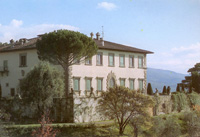 |
|
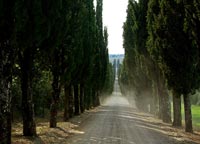 |
Sant'Antimo, between Santa Pia and Montalcino |
|
Villa Gamberaia at Settignano |
|
Villa Arceno gardens |
| |
|
|
|
|
| |
|
|
|
|
The Powerful Families of Renaissance Italy
During the Renaissance, Italy was not a nation but was composed of a number of small, independent city-states. These city-states were governed either by a single family or by a small number of wealthy families. This ruling elite had gained power and prestige not only through their military exploits but also through commerce, banking, and manufacture.
Two of the most famous, or infamous, Renaissance ruling families were the Medici family of Florence and the Borgia family of Rome. Out of all of the powerful Italian city-states, Florence was one that held out the longest. The Medici family rule effectively began with Cosimo Medici who took over his father’s bank in 1429. Within five years, he gained significant political power in Florence, but it wasn’t until his grandson, Lorenzo, destroyed the Florentine republican constitution in 1480 that the Medici family rule was solidified. The Medici family established a hereditary monarchy in Florence, the successors of Lorenzo having ruled until they were kicked out of Florence by Girolamo Savonarola in 1494.
Perhaps less well-known and less powerful than the Medici, the Borgia family has an even more sinister reputation. They are remembered as much for their treachery as for their political accomplishments. The head of the family, Rodrigo Borgia (1431-1503), became Pope Alexander VI in 1492, an office he held until his death in 1503. Although Alexander supposedly died from malaria in 1503 at the age of seventy-two, rumors circulate even now that he met his end after mistakenly eating a piece of poisoned fruit intended for one of his guests.
By the end of the fifteenth and the beginning of the sixteenth century, both the Medici and the Borgia families were in trouble. When Lorenzo the Magnificent died in 1492, the Medici were toppled from power in Florence. Two years later, in 1494, the family was exiled and their property taken over by the city of Venice. Cesare Borgia outlived his father by four years, but steadily lost influence. Beset on all sides by his enemies, foremost among them the new pope Julius II, Cesare fled Rome only to be captured in Naples and imprisoned in Spain. He escaped but was killed in battle in 1507, ending the Borgia's dream of establishing a family dynasty on Italian soil. The Renaissance world of Lorenzo de' Medici and Cesare Borgia may have been beautiful and elegant but it proved also to be dangerous and impossible for any one man or family to master.
The Pazzi family
Like the Albizzi, the Pazzi were an older, nobler lineage than the Medici. The Pazzi family were wealthy bankers that were in a semi-friendly competition with the Medici family. Eventually, they tried to depose the Medicis, failed, and their lineage ended.
They could trace their ancestry back to Pazzino de'Pazzi, the first knight to scale the wall of Jerusalem during the First Crusade. The Pazzi were also wealthy bankers, and enjoyed good commercial terms with their Medici rivals. They even sealed these friendly relations through inter-marriage.
But Lorenzo de'Medici, wary of Pazzi ambition, kept his rivals out of government office during the 1470s. When a greedy nephew of Pope Sixtus IV approached the younger Pazzi with a plan to seize Medici land, they found the chance for power in Florence irresistible. The ambitious sons of Jacopo de'Pazzi led an audacious plot against the Medici.
The plot failed. Executed at the hands of furious Florentines, the name of Pazzi was erased from the city, their homes looted and destroyed. One conspirator was hunted down in the streets of Constantinople, and handed over by the Ottoman Emperor. Even he knew that Lorenzo de'Medici was not to be messed with.
Perhaps by coincidence, the Italian noun for a hot-headed fool is pazzo - and some have suggested that the Italian-American slang, patsy, meaning a scapegoat or stooge, is derived from the unfortunate Pazzi assassins.
The Albizzi family
Florence was controlled by the Albizzi and Pazzi families until about 1438. The Albizzi were one of the oldest families in Florence and led the republican government for two generations. The Albizzi family was a Florentine family originally based in Arezzo, who were rivals of the Medici and Alberti families. They were at the centre of Florentine oligarchy from 1382, in the reaction that followed the Ciompi revolt, to the rise of the Medici in 1434. The most infamous and influential members of the family were Maso and his son Rinaldo degli Albizzi (1370–1442) who countered the rise of Cosimo de' Medici, exiling him in 1433.
By 1427, they were the most powerful family in the city, and far richer than the Medici. They had been the patrons of genius and cultural icons, but the family was more interested in waging war than sustaining commercial viability. The Albizzi family had controlled the republican government for two generations, but they led a lot of costly wars, so the people switched allegiances to the Medici.
Maso degli Albizzi, patriach of his family, had two sons, Luca and Rinaldo. From a young age, Luca was friends with Cosimo de'Medici. They shared a passion for classical learning and good conversation. During the 1420s, Luca declared his public allegiance to the Medici family, even marrying Cosimo's cousin. For his hot-headed brother Rinaldo, this was a humiliation too far. The bitter family rivalry had just got personal.
Rinaldo's impatience got the better of him. Eager to flush Cosimo out of Florence, he allowed the head of the Medici family to stay alive, gathering support whilst in exile. And Rinaldo's rash decision to besiege the Palazzo Vecchio when he didn't get his way allowed Cosimo to return triumphant. The Albizzi were banished, never to return to power in Florence. The Albizzi family supported a lot of artists and cultural icons. The family palazzo in Borgo degli Albizzi, was rebuilt at the return of the family in the early 16th century.
The Strozzi family
The Strozzi family was an ancient and noble Florentine family. Palla Strozzi (1372-1462) played an important part in the public life of Florence, and founded the first public library in Florence in the monastery of Santa Trinita. Filippo Strozzi il Vecchio (1428-1491), son of Matteo Strozzi and of Alessandra Macinghi is credited with initiating construction of the Strozzi palace in Florence.
Filippo II (1488-1538) is probably the most well known member of the family. Although married to Clarice de' Medici, a daughter of Piero di Lorenzo de' Medici and member herself of the Medici family, he was vehemently opposed to the hegemony the Medicis had acquired as the unofficial rulers of the Florentine republic and was among the leaders of the uprising of 1527.
After the republic was overthrown in 1530 Alessandro de' Medici attempted to win Filippo Strozzi's support, but Strozzi declined and instead retired to Venice. After the murder of Alessandro in 1537 he assumed leadership of a group of republican exiles with the object of re-entering the city but having been captured and subsequently tortured he committed suicide.
Filippo II (1488-1538) is probably the most well known member of the family. Although married to Clarice de' Medici, a daughter of Piero di Lorenzo de' Medici and member herself of the Medici family, he was vehemently opposed to the hegemony the Medicis had acquired as the unofficial rulers of the Florentine republic and was among the leaders of the uprising of 1527.
Filippo Strozzi's older son Piero (1500 - 1558), fought in France against Italy and Spain, and was made a Marshal of France in 1554. He took part in the French siege of Calais (1557), and died of wounds incurred in battle at Thionville, in Lorraine, in 1558. The younger son Leone (1515-1554) was a distinguished admiral in the service of France and fought against the Medici. He died of a wound received while attacking Sarlino in 1554.
Filippo di Piero Strozzi (1541-1582) served in the French army, and was captured and killed by the Spaniards at the Battle of Terceira.
Until its exile from Florence in 1434, the Strozzi family was by far the richest in the city, and was rivaled only by the Medici family, who ultimately took control of the government and ruined the Strozzi both financially and politically. This political and financial competition was the origin of the Strozzi-Medici rivalry. Later, while the Medici ruled Florence, the Strozzi family was ruling Siena. Florence attacked Siena at that time, which caused great animosity between the two families. Soon afterwards, the Strozzi married into the Medici family, essentially giving the Medici superiority.
The Strozzi acquired by marriage the titles of Princes of Forano and Dukes of Bagnolo. The Strozzi palace belonged to the family until 1937 when it was sold to the National Insurance Institution 'Istituto Nazionale delle Assicurazioni (INA).From 1999 it became Italian State's property.
Today, the Strozzi descendents are still living in Florence.
The Rucellai family
Giovanni Rucellai is the name of a father (1403–1481) and grandson (1475–1525) of the Rucellai family wool-dyers turned bankers.
The former, Giovanni di Paolo, or Giovanni I, as the effective head of the Rucellai family commissioned the building of the Palazzo Rucellai, designed by Leon Battista Alberti and the father of Bernardo Rucellai, the oligarch and humanist. The son-in-law of Palla Strozzi, Giovanni di Paolo was close friends with Piero di Cosimo de' Medici and his wife, Lucrezia Tornabuoni. He served as Prior in 1463 and as Gonfaloniere di Giustizia in 1475. His eldest son, Bernardo, married Nannina de' Medici. Giovanni the Elder was well-acquainted with the classics - he kept a Zibaldone in which his own translations of passages from Greek and Latin authors, like Aristotle and Boethius as well as the letters of Seneca the Younger were copied out.
Giovanni di Paolo was an outstanding patron of the arts, matched only by Cosimo de' Medici in fifteenth-century Florence. He commissioned works for the Palazzo Rucellai from such renowned artists as Andrea di Castagno, Desiderio da Settignano, Filippo Lippi, Piero Pollaiuolo, Uccello, Verrocchio, Domenico Veneziano, Vittorio Ghiberti and Giovanni Bertini. The marble Alberti facade of Santa Maria Novella was but one of the family's donations of public art.
The latter, Giovanni di Bernardo, or Giovanni II, was an Italian humanist, poet, dramatist and man of letters, and a cousin of Pope Leo X. He was also an important figure in the fields of commerce and politics, being in his lifetime the third richest man in Florence, a situation that was added to by his marrying into the powerful Strozzi and Medici families.
The Brancacci family
Felice di Michele Brancacci (born 1382 - fl. 15th century) was a Florentine silk merchant, best known for commissioning the decoration of the Brancacci Chapel. The nephew and heir of Piero di Piuvichese Brancacci, he was involved in Mediterranean silk trade, and also acted as a diplomat.
Felice is known to have won a joust held to celebrate Florence's submission of Pisa in 1406. He acted as a diplomat for the Florentine Republic, and visited the court of the Sultan of Egypt in 1422. He was also a member of the city's Board of Maritime Consuls. As a result of the decline in the wool trade, Brancacci's wealth as a silk merchant increased rapidly. In May 1431 he married Lena, daughter of Palla Strozzi, a union that put him at the centre of Florentine politics. In 1433, a number of the most powerful families of the city – including the Strozzis – had driven the family of Cosimo de Medici into exile. When the Medicis returned in triumph the next year, Brancacci was among those expelled as an enemy of the Republic, in spite of his attempts to stay out of active political ploys.
Sometime after 1423 and before 1425 Brancacci supposedly commissioned the painter Masaccio to decorate the walls of the Brancacci chapel left by his uncle. The subject was the life of Saint Peter, the name-saint of the founder, and the patron saint of the Brancacci family. The choice also reflected support for the Roman papacy during the Great Schism. Masolino was later joined by the younger artist Tommaso Cassai, or Masaccio. Masaccio's contributions to the frescoes – including The Tribute Money – are considered the most important, and central to the development of renaissance art. Both artists left before the work was completed, however, in 1427 or 28. It was not until the 1480s, when the Brancaccis were allowed to return from exile, that the work was finished, by Filippino Lippi.
The Borgia family
At the time of the Borgia papacy, Italy was ruled by several types of government: territorial overlords called signore, marquises, dukes, and kings - as in the case of Naples (Venice was an oligarchial republic ruled by a military duke, called the Doge). Some of these princes were technically papal vassals - hereditary rulers who received the rights to own and inherit immovable property and revenue. They "owned" their lands under two major conditions: 1. They must send annual tribute to the granter, and 2. They must defend and protect the interest of the granter. The Kingdom of Italy, when it was a satellite of the Holy Roman Empire under Frederick I (Barbarossa), was ruled by imperial vassals who held northern Italian lands in fief for the Holy Roman Emperor. Gradual changes in the makeup of the Holy Roman Empire led to the deterioration of its control in much of northern and central Italy. Some of these lords and princes gradually asserted their authority and maintained their independence from the Empire. At the same time, they were alternately free, papal, and conquered realms until the Italian Wars (1494-1550s) and later Unification of Italy (1850s).
Many important cities in Renaissance Italy were ruled by hereditary noble families, elites in control of independent communes, republics, and former imperial fiefs that were at war with one another throughout of the 13th and 14th centuries. The borders of 1492 Italy were continually being shaped by some of these powerful ruling dynasties: the House of Este, the House of Medici, the House of Este, Dukes of Ferrara; the House of Sforza, Dukes of Milan; the House of Medici, Citizens of Florence; the House of Gonzaga, Marquises of Mantua; the House of Orsini; the House of Aragon (Naples); the House of Colonna; the House of Orsini, Lords of Bracciano; the House of Montefeltro, Dukes of Urbino; the House of Aragon, Kings of Naples; the House of Colonna, Lords of Palestrina; he House of Bentivoglio, Lords of Bologna, the House of Baglioni; Lords of Perugia, the House of Malatesta, Lords of Rimini and the House of Petrucci, Lords of Siena.
|
|
|
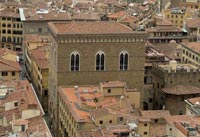 |
|
 |
Lucca, Anfiteatro |
|
Florence, Orsanmichele |
|
Florence, Duomo Santa Maria del Fiore |
| |
|
|
|
|
|
|
|
|
|
| Palazzi a Firenze / Palaces in Florence | Palazzo Acciaiuoli, Palazzo Adorni Braccesi, Palazzo degli Alessandri, Palazzo dell'Antella, Palazzo Antinori, Palazzo Arcivescovile, Palazzo dell'arte dei Beccai, Palazzo dell'Arte dei Giudici e Notai, Il Bargello, Palazzo Bartolini Salimbeni, Palazzo de' Benci, Palazzo di Bianca Cappello, Palazzo Buondelmonti, Palazzo dei Canonici, Palazzo Capponi Covoni, Palazzo Cocchi-Serristori, Palazzo dei Congressi, Palazzo Corsini, Palazzo Corsini al Prato, Villa Corsini a Castello, Palazzo Da Cintoia, Palazzo della Gherardesca, Palazzo Fenzi, Palazzo dei Frescobaldi, Palazzo Galileo, Palazzo Gondi, Palazzo Lenzi (French Consulate), Palazzo Giugni, Palazzo Guadagni, Palazzina della Livia, Palazzo Malenchini-Alberti, Palazzo Medici-Riccardi, Palazzo Mellini Fossi, Palazzo della Misericordia, Palazzo della Missione, Palazzo dei Mozzi, Palazzo Nasi, Palazzo Nonfinito, Palazzo Pandolfini, Palazzo Pazzi, Villa la Petraia, Palazzo Pitti, Palazzo Portinari Salviati, Palazzo delle Poste Centrali, Palazzo Pucci, Palazzo Ramirez de Montalvo, Palazzo Ricasoli, Palazzo Rucellai, Palazzo Sacrati (Guadagni-Strozzi di Mantova), Casino Salviati, Palazzo di San Clemente, Palazzetto Serragli, Palazzo Serristori, Palazzo Spini Feroni, Palazzo Strozzi, Palazzo Taddei, Palazzo Torrigiani Del Nero, Palazzo Uguccioni, Palazzo di Valfonda, Palazzo Vecchio, Villa il Ventaglio, Palazzo dei Visacci, Palazzo Vivarelli Colonna |
This page uses material from the Wikipedia articles Palazzo Medici Riccardi published under the GNU Free Documentation License.
Wikimedia Commons has media related to Palazzo Medici-Riccardi and to the Garden of Palazzo Medici-Riccardi.
|
|
|
![]()
![]()
![]()
![]()
![]()

